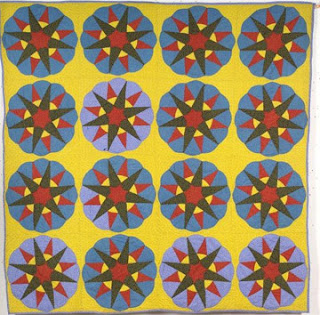Quilt in a regional design from Tennessee and Texas
Most of the yellows we see in 19th-century quilts were dyed with chrome.
Sampler block, 1840-1860
Chrome yellow and chrome orange
Chrome yellow is closely related in chemistry to chrome orange (what we call cheddar today). It's a true yellow that the dyers called canary yellow.
Pennsylvania quilt 1880-1910
Swatch glued in a 19th-century dye book
showing chrome or canary yellow.
The color changes when it comes in
contact with certain chemicals---
like the acids in an old book's pages.
Chrome yellow could be bought as a solid or a print.
Pennsylvania, end of the 19th century.
The color was important in Pennsylvania German design, which emphasized bright next to bright.
So we see many Pennsylvania quilts using the color.
Block about 1840-60
Quilters all over the country used it, however.
The chrome yellow process was developed early in the 19th century, but we really don't start seeing a lot of it until the 1840s when it became important for applique and piecing.
It's difficult to determine whether a print is 1860 or 1890.
The common combinations were red and black (dark brown) figures on yellow grounds.
The major difference between mid-century prints and those from the end of the 19th-century is that the later prints became more standardized. There just wasn't a lot of variety. Mills printed the same design in the same color for decades, marketing them as old-fashioned calicoes.
Top from the 1940s?
Apron from the 1960s or 1970s.
The yellow prints were almost the same for a hundred years.
But then... they stopped printing them about 1980.
Until now!
Reproduction of a classic yellow print 1860-1980
Here's a reproduction of a 1960s interpretation of the old prints---
a repro of a repro that Moda and I are doing in a collection of
Old Fashioned Calicoes.
Start thinking canary and click here.


















Oh Happy Day.....Old fashioned calicoes, the repro's I learned to quilt with in the 60's are coming back, that is indeed very good news!
ReplyDeleteThanks
Wendy
Love the old calicoes in your new collection. Very interesting about the history of yellow dye. Makes you realize how many choices we have today that we don't think twice about. Thanks for sharing the lovely historical photos.
ReplyDeleteLoved the photos in your Chrome Yellow blog.
ReplyDeleteOld Fashioned Calicoes have such a cheerfulness about them - I still have a few scraps from long ago when they were only 36 inches wide!
An interesting post with some great pictures! I love the sampler block with the squirrel eating - I've been planning to make a block with a squirrel eating an apple for my CWB quilt.
ReplyDeleteI have examples of yellow calico in 24 inch width and the same print in 36 inch width, supporting the fact that they were printed over a span of time. Also, I am the proud owner of the PA crib quilt that you show.
ReplyDeleteIt's always fun to find out where those auction quilts wind up---that is a great little quilt.
ReplyDeleteWonderful examples of quilts with the chrome yellow in them. I do have a hand painted candle holder, similar to the cup.
ReplyDeleteDebbie
Thank you for sharing the info about chrome yellow and cheddars...
ReplyDeleteThat first antique quilt you feature is simply amazing. I am always in awe of the earlier quiltmakers and what they accomplished...no Ott lights, no rotary cutters or specialty rulers and often a brilliant design and color combination that is in their own imagination. Such inspiration!
It is a dreary day here in Michigan, but it certainly was made a lot brighter by your wonderful blog on chrome yellow. Thank you so much.
ReplyDeleteMy mother laughs at me because I've recently purchased vintage quilts with the chrome orange color prominent in the design. She never would have pegged me as an orange person, and I wasn't until I got interested in making reproduction quilts.
ReplyDeleteI find that yellow and purple are the two colors not largely represented in my fabric collection. I am slowing working toward improving that condition.
Just a quick note to let you know that a link to this post will be placed on CraftCrave today [18 Oct 09:00pm GMT]. Thanks, Maria
ReplyDeleteI still have several of these in my scrap drawers from the 1970s! A company called Yours Truly used to sell them in flat fold bundles through the mail.
ReplyDeleteCynthia Collier
Great post. I'm SO happy you're recreating these!! I've been picking them up from vintage suppliers any time I find them, but yours will be much better. I'm going to buy them all!!
ReplyDeleteHoly cow that quilt at the top is in nine, with the little sun-wheels in eleven? Wow that's some math all right.
ReplyDeleteI totally have some of those ubiquitous yellow calicoes from various scrap bags from the 70s.
I've been wondering lately about mauve, the famous first synthetic dye. I was looking at reproduction Civil War fabric (funny that) and noticed a very particular shade of lavender/purple. At first I thought well maybe they're imitating the kind of color you get from logwood, but then I remembered mauve. I know what we call 'mauve' nowadays, but I don't know if I've ever seen something dyed with the real thing.
Mauve was a synthetic dye for silks and wools. I'll get together some photos and write about purples in cotton and mauve some time soon.
ReplyDeleteOh wonderful; I look forward to it. Thanks!
ReplyDeleteI still have a few little bits of scraps of those wonderful old calicos from the 60's and 70's. So glad you're bringing them back! I can't wait!
ReplyDeleteLove them!!
ReplyDelete